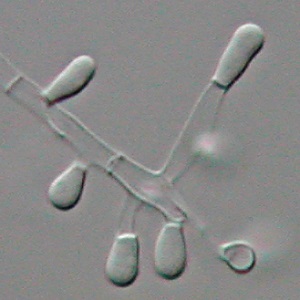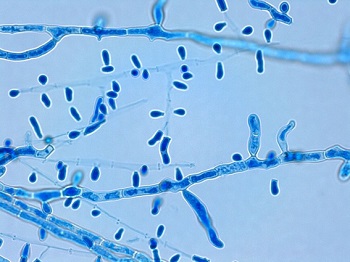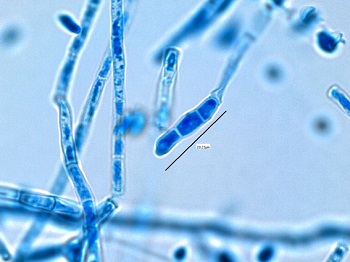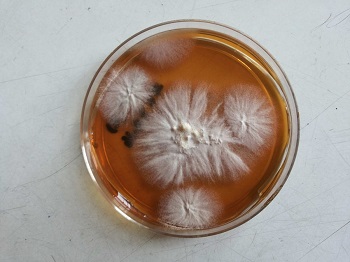Trichophyton tonsurans - Introduction, Classification, History, Habitat, Morphology, Culture, Identification
Introduction to Trichophyton tonsurans
Trichophyton tonsurans is a fungus that causes ringworm on the scalp. Although, it commonly causes Tinea capitis, other clinical syndromes such as Tinea corporis, onychomycosis, and Tinea pedis may occur.
Trichophyton tonsurans can produce melanin which acts as an antioxidant and protects the fungus from damaging UV rays. This characteristic is essential in sunny regions where it is endemic.
Classification of Trichophyton tonsurans
Kingdom: Fungi
Division: Ascomycota
Class: Eurotiomycetes
Order: Onygenales
Family: Arthrodermataceae
Genus: Trichophyton
Species: T. tonsurans
History of Trichophyton tonsurans
Historically, Trichophyton tonsurans were first described in 1844 by Hungarian physician David Gruby.
Habitat of Trichophyton tonsurans
Trichophyton tonsurans infect the scalp in humans resulting in a ringworm condition known as Tinea capitis.

Trichophyton tonsurans arthrospores (Source: Wikipedia)
Morphology of Trichophyton tonsurans
In non-living keratinized tissue, Trichophyton tonsurans form only hyphae and arthroconidia i.e. arthrospores. These arthrospores are individual cells fragmented from the hyphae.
Trichophyton tonsurans colonies are flat, and cream-colored while the reverse side is yellow to tan (yellowish brown) to rust red. It develops into folded colony whose color may range from off-white to grey. Dark pigments may be present which diffuses into the culture medium.
The microconidia of Trichophyton tonsurans are abundant in number. They are club-shaped, clavate, to teardrop shaped with flat bottoms that are larger than that of other Trichophyton spp. They are borne on short branches.
Macroconidia of Trichophyton tonsurans are rare but if present is balloon-like in shape and 4-6 cells long.

Trichophyton tonsurans microconidia (Source: Fun With Microbiology)

Trichophyton tonsurans macroconidia (Source: Fun With Microbiology)
Culture of Trichophyton tonsurans
Like most fungi, Trichophyton tonsurans can be cultured in a laboratory.
It grows on Sabouraud’s Dextrose Agar (SDA) incorporated with chloramphenicol and cycloheximide and incubated at 25 to 30°C aerobically for 1 to 3 weeks.
Growth of Trichophyton tonsurans is enhanced in the presence of thiamine which is used for distinguishing it from other species of Trichophyton.
Melanin production by Trichophyton tonsurans can be induced in caffeic acid media in-vitro.

Trichophyton tonsurans colony (Source: ResearchGate)
Identification of Trichophyton mentagroohytes
The fungi Trichophyton tonsurans are identified on the basis of colony morphology, color, pigment production, and presence/absence of microconidia or macroconidia.
Fresh culture extracted from the agar plate using cellophane tape and placed on a slide containing a drop of Lacto Phenol Cotton Blue (LPCB). The preparation is viewed under a microscope to demonstrate the presence/absence of microconidia or macroconidia.
Trichophyton tonsurans colonies are flat, and cream-colored while the reverse side is yellow to tan (yellowish brown) to rust red. It develops into folded colony whose color may range from off-white to grey. Dark pigments may be present which diffuses into the culture medium.
The microconidia of Trichophyton tonsurans are abundant in number. They are club-shaped, clavate to teardrop shaped with flat bottoms that are larger than that of other Trichophyton spp. They are borne on short branches.
Macroconidia of Trichophyton tonsurans are rare but if present is balloon-like in shape and 4-6 cells long.
In the early stages, chlamydospore-like structures (CLS) are formed on the reverse side of the culture – when viewed under a light microscope. Chlamydospores, which are asexual spores formed through hyphal modification, mycelia extend into the media to create CLS. The presence of CLS becomes prominent after 5 days of incubation.
Growth of Trichophyton tonsurans is enhanced in the presence of thiamine which is used for distinguishing it from other species of Trichophyton.
BCP-milk solids glucose agar can also be used for the identification of Trichophyton tonsurans. After 7–14 days of incubation at 25 °C, the medium turns from pale blue to purple indicating an alkaline shift due to the release of ammonium from protein hydrolysis.